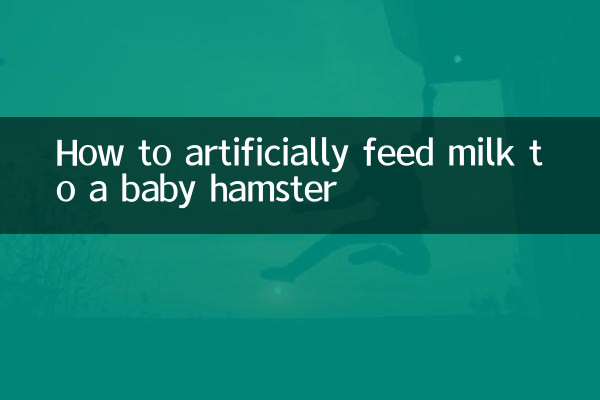How to artificially feed milk to a baby hamster
Among the hot topics in the past 10 days, pet care, especially the feeding of small hamsters, has attracted widespread attention. Many pet owners require artificial feeding because their mother hamsters are unable to nurse or their pups are abandoned. This article will introduce in detail how to artificially feed hamsters safely and effectively, and provide structured data to help you quickly grasp key information.
1. The necessity of artificial breastfeeding

Artificial breastfeeding is usually required when:
| Condition | illustrate |
|---|---|
| Mother hamster dies or refuses to nurse | Pups cannot get breast milk |
| cub abandoned | Female hamsters may be abandoned due to stress or health problems |
| Too many cubs | Mother hamster cannot take care of all her pups |
2. Required tools and materials
Here is a list of tools and materials needed for artificial breastfeeding:
| Tools/Materials | use |
|---|---|
| Special bottles or droppers for pets | Used for breastfeeding to avoid choking on milk |
| Hamster milk powder or goat milk powder | Replace breast milk with balanced nutrition |
| Warm water | Prepare milk powder and control the temperature at 35-38°C |
| clean towels | Clean and keep pups warm |
| electronic scale | Monitor changes in pup weight |
3. Steps of Artificial Breastfeeding
The following are the specific steps for artificial breastfeeding:
| step | Operating Instructions |
|---|---|
| 1. Prepare milk powder | Prepare the milk powder according to the instructions in the instructions, and control the temperature at 35-38°C. |
| 2. Prepare feeding tools | Use a bottle or dropper and make sure it is clean |
| 3. Breastfeeding posture | Hold the cub gently and raise its head slightly to avoid choking on the milk. |
| 4. Feeding volume | The amount of milk fed each time is about 5%-10% of the cub's weight, 4-6 times a day |
| 5. Cleaning | Use a wet towel to clean the pup's mouth and body after feeding |
| 6. Keep warm | After feeding, return the pups to a warm environment, keeping the temperature at 28-32°C |
4. Precautions
The following matters need to be paid attention to during artificial breastfeeding:
| Things to note | illustrate |
|---|---|
| Avoid choking on milk | Feed slowly and observe the cub's reaction |
| Monitor weight | Weigh your pups every day to ensure they grow up healthily |
| Don't feed milk | Milk may cause diarrhea, so use hamster-specific milk powder |
| maintain hygiene | All tools and materials need to be cleaned and disinfected |
| Observe health status | If diarrhea, refusal to eat, etc. occur, seek medical attention promptly. |
5. Frequently Asked Questions
Here are some frequently asked questions and answers:
| question | answer |
|---|---|
| What should I do if my cub refuses milk? | Check whether the milk temperature is appropriate and try feeding slowly with a dropper |
| How to determine feeding frequency? | Adjust based on pup age and weight, usually every 2-4 hours |
| How to store milk powder? | After opening, seal and refrigerate, and use within 7 days |
| When can pups be weaned? | Usually start solid foods at 3-4 weeks of age |
6. Summary
Artificially feeding baby hamsters is a task that requires patience and care. By learning the right feeding techniques, using the right tools and materials, and paying close attention to your pup's health, you can successfully help your baby hamster grow up healthy. If you encounter any problems during the feeding process, it is recommended to consult a veterinarian or pet care expert promptly.
I hope this article can provide you with practical help, and I wish you and your little hamster health and happiness!

check the details

check the details